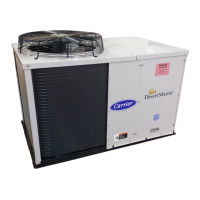ROUTING POWER LEADS INTO UNIT - Use only copper wire between disconnect and unit. The high-voltage leads
should be in a conduit until they enter the unit;
conduit termination at the unit must be watertight. Run the high-voltage
leads through the hole on the control box side of the unit (See Fig. 5). When the leads are inside the unit, run leads to
the control box (See Fig. 6). Connect leads to the black and yellow wires.
CONNECTING GROUND LEAD TO UNIT GROUND - Connect the ground lead to the chassis using the unit ground in
the control box.
Fig. 5 - Unit Electrical Connection Fig. 6 - Control Box Wiring
ROUTING CONTROL POWER WIRES (24-V) - Form a drip-loop with the thermostat leads before routing them
into the unit. Route the thermostat leads through grommeted hole provided in unit into unit control box (See Fig. 5).
Connect thermostat leads and unit power leads as shown in Fig. 7 and Fig. 8.
Route thermostat wires through grommet providing a drip-loop at the panel. Connect low-voltage leads to the
thermostat as shown in Fig. 8. The unit transformer supplies 24-v power for complete system including accessory
electrical heater. Transformer is factory wired for 230-v operation. Unit main harness contains a 3 amp automotive
style replaceable fuse. If transformer secondary voltage is not available at red and brown leads in unit low voltage box,
check fuse in red lead near transformer.
Fig. 7 - Line Power Connections
Unit main harness also contains a 1k ohm, 3 watt load resistor wired across low voltage leads “G” and “C”. Purpose of
resistor is to provide a small electrical load for the indoor thermostat fan circuit to ensure reliable operation.
ACCESSORY ELECTRIC HEAT WIRING - Refer to accessory electric heat installation instructions for information on
installing accessory electric heat. Accessory electric heat wiring is shown in Typical Wiring Diagram.

